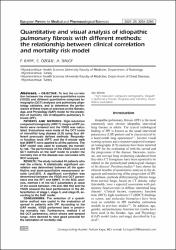| dc.contributor.author | Kaya, Furkan | |
| dc.contributor.author | Özgül, Esra | |
| dc.contributor.author | Balcı, Aydın | |
| dc.date.accessioned | 2022-05-31T08:19:07Z | |
| dc.date.available | 2022-05-31T08:19:07Z | |
| dc.date.issued | 2021 | en_US |
| dc.identifier.citation | Kaya, F., Özgül, E., & Balcı, A. (2021). Quantitative and visual analysis of idiopathic pulmonary fibrosis with different methods: The relationship between clinical correlation and mortality risk model. Eur. Rev. Med. Pharmacol. Sci, 25, 3254-3263. | en_US |
| dc.identifier.issn | 1128-3602 | |
| dc.identifier.uri | https://doi.org/10.26355/eurrev_202104_25734 | |
| dc.identifier.uri | https://hdl.handle.net/20.500.12933/1128 | |
| dc.description.abstract | OBJECTIVE: To test the correlation between the visual semi-quantitative score (VSQS) and different quantitative computed tomography (QCT) analyses and pulmonary physiology variables, and to determine the performance of these types of analyses on the Gender, Age, and Physiology (GAP) model for the prediction of mortality risk of idiopathic pulmonary fibrosis (IPF).
PATIENTS AND METHODS: High-resolution computed tomography (HRCT) images of IPF patients were reviewed and the VSQS was calculated. Evaluations were made of the QCT score of interstitial lung disease (ILD) using four different previously defined methods. Respiratory function tests (RFT) and the 6-minute walk test (6MWT) were applied to all the patients. The GAP model was used to evaluate the mortality risk. The performance of the VSQS score and QCT methods on the GAP model to predict the mortality risk of the disease was calculated with ROC analysis.
RESULTS: The study included 40 patients who met the criteria. A statistically significant correlation was determined between all the quantitative and semi-quantitative measurement results (p<0.001). A significant correlation was determined between the VSQS and QCT parameters and the RFT and 6MWT. In the ROC analysis, method 4 of the QCT parameters (a value of the voxels between -700 and -950 HU) and the VSQS showed the best performance in the differentiation of stage I, stage II, and stage III, according to the GAP model.
CONCLUSIONS: The selection of a quantitative method was useful in the evaluation of spread in patients with IPF. According to the GAP model, VSQS performed best in predicting mortality risk. Furthermore, method 4 of the QCT parameters, which shows well-aerated lungs, were deemed to have good potential for the estimation of mortality risk. | en_US |
| dc.language.iso | eng | en_US |
| dc.publisher | Verduci | en_US |
| dc.relation.isversionof | 10.26355/eurrev_202104_25734 | en_US |
| dc.rights | info:eu-repo/semantics/openAccess | en_US |
| dc.subject | High resolution computed tomography | en_US |
| dc.subject | Idiopathic pulmonary fibrosis | en_US |
| dc.subject | Prognosis and mortality | en_US |
| dc.subject | Quantitative evaluation | en_US |
| dc.title | Quantitative and visual analysis of idiopathic pulmonary fibrosis with different methods: the relationship between clinical correlation and mortality risk model | en_US |
| dc.type | article | en_US |
| dc.authorid | 0000-0001-8619-7593 | en_US |
| dc.authorid | 0000-0002-6005-134X | en_US |
| dc.authorid | 0000000267232418 | en_US |
| dc.department | AFSÜ, Tıp Fakültesi, Dahili Tıp Bilimleri Bölümü, Radyoloji Ana Bilim Dalı | en_US |
| dc.contributor.institutionauthor | Kaya, Furkan | |
| dc.contributor.institutionauthor | Özgül, Esra | |
| dc.contributor.institutionauthor | Balcı, Aydın | |
| dc.identifier.volume | 25 | en_US |
| dc.identifier.issue | 8 | en_US |
| dc.identifier.startpage | 3254 | en_US |
| dc.identifier.endpage | 3263 | en_US |
| dc.relation.journal | European Review for Medical and Pharmacological Sciences | en_US |
| dc.relation.publicationcategory | Makale - Uluslararası Hakemli Dergi - Kurum Öğretim Elemanı | en_US |
















